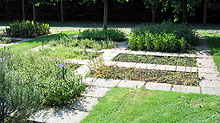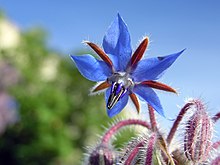Kitchen garden


The traditional kitchen garden, also known as a potager (from the French jardin potager) or in Scotland a kailyaird,[1] is a space separate from the rest of the residential garden – the ornamental plants and lawn areas. Most vegetable gardens are miniature versions of old family farm plots, but the kitchen garden is different not only in its history, but also its design. It differs from an allotment in that a kitchen garden is on private land attached to the dwelling.
The kitchen garden may serve as the central feature of an ornamental, all-season landscape, or it may be little more than a humble vegetable plot. It is a source of herbs, vegetables and fruits, but it is often also a structured garden space with a design based on repetitive geometric patterns. It has year-round visual appeal and can incorporate permanent perennials or woody shrub plantings around (or among) the annuals.
History[]
Charles Estienne wrote in detail about the 16th century kitchen garden in Maison Rustique. This practical garden was to be separated from the pleasure gardens, enclosed by a thick hedge or stone wall. Hedges were viewed as more resilient, cost effective and were easier to repair and maintain. The hedge, he says, can be planted with red and white gooseberry bushes, medlar and olive trees, woodbine, whitethorn, wild apples, brambles, and eglantiness. Lattices were woven from willow branches and every year renewed, unless made with juniper poles that had been reinforced with charred oak.
Of the planted crops, turnips required the most room, and planted next to these were coleworts, and a path leading to plots of sorrel, arugula, parsley, spinach, beets, and orach, then separated from the greens another path to the root vegetables, leeks, onions, garlic, carrots, and scallions, and so on for edible flowers and winter potherbs like thyme, sage, lavender, rosemary, hyssop, southern wormwood, savoury, lemon balm, basil, costmary, spikenard, chamomile, and pennyroyal.
Marigolds could grow perennially in untilled fields, and their juice and flowers were reputed to have many benefits from soothing eye irritation to relieving tooth pain. Strawberry juice and wine were rumored to have similar benefits for the eyes, and, according to Estienne, the berries themselves had "no neede of greate toile or tilling". Modern researchers continue to study whether reduced tillage improves weed control and yield for strawberry plants.[2]
Other plants found in the kitchen garden: asparagus, artichoke, sow thistle, endive, chicory, watercress, scallions, chives, parsnips, purslane, smallage, tarragon, borage, bugloss, radishes, rapeseed, skirret, poppy, mustard, cucumbers and gourds.
Citrus and melons could be part of the kitchen garden also, if the conditions of soil and climate were such as to support their growth.
Potager garden[]

One historical design precedent is from the Gardens of the French Renaissance and Baroque Garden à la française eras potagers. In this type of vegetable garden, flowers (edible and non-edible) and herbs are often planted with the vegetables to enhance the garden's beauty.[3] The goal is to make the function of providing food aesthetically pleasing.
Plants are chosen as much for their functionality as for their color and form.[4] Many are trained to grow upward. A well-designed potager can provide food as well as cut flowers and herbs for the home with very little maintenance.[3] Potagers can disguise their function of providing for a home in a wide array of forms—from the carefree style of the cottage garden to the formality of a knot garden.
Vegetable garden[]



A vegetable garden (also known as a vegetable patch or vegetable plot) is a garden that exists to grow vegetables and other plants useful for human consumption,[5][6] in contrast to a flower garden that exists for aesthetic purposes. It is a small-scale form of vegetable growing. A vegetable garden typically includes a compost heap, and several plots or divided areas of land, intended to grow one or two types of plant in each plot. Plots may also be divided into rows with an assortment of vegetables grown in the different rows. It is usually located to the rear of a property in the back garden or back yard.[5] About a third of adults in the UK and America grow food in private or community kitchen or vegetable gardens.[7][8] In World War II, many people had a "victory garden" which provided food and thus freed resources for the war effort.[9]
With worsening economic conditions and increased interest in organic and sustainable living, many people are turning to vegetable gardening as a supplement to their family's diet. Food grown in the back yard consumes little if any fuel for shipping or maintenance, and the grower can be sure of what exactly was used to grow it. Organic horticulture, or organic gardening, has become increasingly popular for the modern home gardener.[10]
Herb garden[]
The herb garden is often a separate space in the garden, devoted to growing a specific group of plants known as herbs. These gardens may be informal patches of plants, or they may be carefully designed, even to the point of arranging and clipping the plants to form specific patterns, as in a knot garden.
Herb gardens may be purely functional or they may include a blend of functional and ornamental plants. The herbs are usually used to flavour food in cooking, though they may also be used in other ways, such as discouraging pests, providing pleasant scents, or serving medicinal purposes (such as a physic garden), among others.
A kitchen garden can be created by planting different herbs in pots or containers, with the added benefit of mobility. Although not all herbs thrive in pots or containers, some herbs do better than others. Mint, a fragrant yet invasive herb, is an example of an herb that is advisable to keep in a container or it will take over the whole garden.[11][12][13]
See also[]
- List of garden types
- Kailyard school
- The Victorian Kitchen Garden
References[]
- ^ Scots "kailyaird" or "kailyard", means a small cabbage patch (see kale) or kitchen garden, usually adjacent to a cottage.--Cuddon, J. A. (1977) A Dictionary of Literary Terms. London: André Deutsch; p. 343.
- ^ McDermott, Laura. "Optimizing Strawberry Production With A Reduced Tillage System" (PDF). Cornell University Cooperative Extension.
- ^ Jump up to: a b Titmarsh, Alan (January 26, 2014). "Grow your veggies in style! How to create a kitchen garden". The Express. Retrieved May 9, 2017.
- ^ Hendry, Ann Marie. "How to Design a Potager Garden". growveg.co.uk. Retrieved May 9, 2017.
- ^ Jump up to: a b Komar, Stephen (May 7, 2017). "Some tips as you prepare your spring vegetable garden". New Jersey Herald. njherald.com. Retrieved May 9, 2017.
- ^ "Planning a vegetable garden". rhs.org.uk. Retrieved May 9, 2017.
- ^ "'Rising numbers' growing own food". May 17, 2012 – via www.bbc.co.uk.
- ^ "Gardening Boom: 1 in 3 American Households Grow Food". Farmer Foodshare.
- ^ Pack, Charles Lathrop (1919). War Gardens Victorious. J. B. Lippincott. p. 15.
- ^ Buckland, Toby. "The beginner's guide to starting a veg garden". The Telegraph. Retrieved May 9, 2017.
- ^ "Gardening Design". Neta Design. May 24, 2020.
- ^ "Mint and the Home Vegetable Garden". VegetableGardenHub.com. Retrieved May 19, 2012.
- ^ "Gardening Guide". Sunday, March 15, 2020
Further reading[]
- Bartley, Jennifer R. (2006). Designing the New Kitchen Garden: An American Potager Handbook. Portland: Timber Press. ISBN 978-0-88192-772-6.
- Davies, Jennifer (1987). The Victorian Kitchen Garden. London: BBC Books. ISBN 978-0-563-20442-8.
- M. D. (1901) "Formation of the Fruit and Kitchen Garden", in: Thompson, Robert The Gardener's Assistant; new edition, revised ... under the direction and general editorship of William Watson. Vol. IV, pp. 1–32. London: Gresham Publishing Company.
- Shewell-Cooper, W. E. (1947) The A.B.C. of Vegetable Gardening London: English Universities Press (first published 1937).
- Wilson, C. A. (ed.) (1998). The Country House Kitchen Garden 1600–1950: How Produce Was Grown and How it Was Used. Sutton Publishing. ISBN 978-0-7509-1423-9.
External links[]
- Urban Leaf: A useful knowledge base for aspiring gardeners with a lot of information about getting started
- Kitchen Gardeners International: A nonprofit group promoting kitchen gardens worldwide
- Walled Kitchen Gardens Network
- Kitchen Gardens, Science Tracer Bullet, Library of Congress
- The History of Kitchen Gardens in America, Cornell University, Mann Library
- Herb Society of America
- National Herb Garden, United States National Arboretum
- Medicinal Herb Garden, University of Washington, USA
- Organic gardening
- Types of garden
- Garden features
- Landscape architecture
- Horticulture and gardening
- Herb gardens


